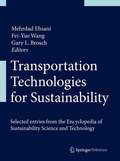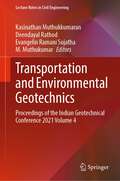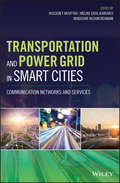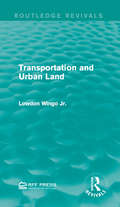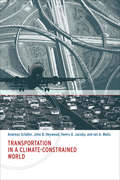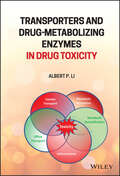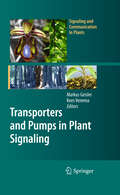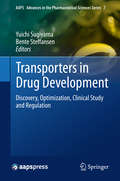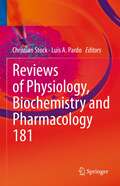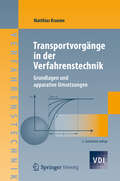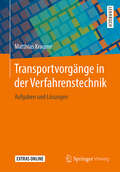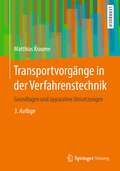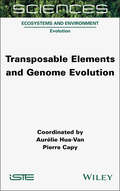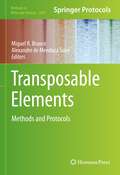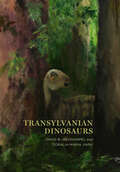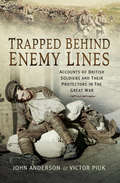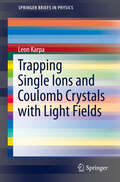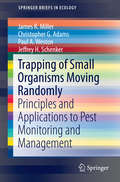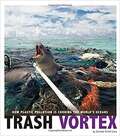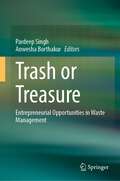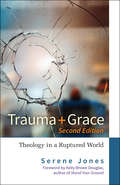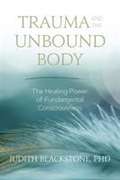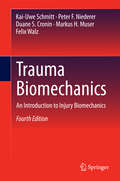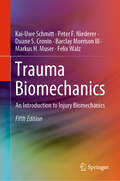- Table View
- List View
Transportation Technologies for Sustainability
by Fei-Yue Wang Gary L. Brosch Mehrdad EhsaniInnovative transportation technologies will be a vital component of any future sustainable society. Gathering over 50 authoritative, peer-reviewed entries from the Encyclopedia of Sustainability Science and Technology, Transportation Technologies for Sustainability covers a broad range of transportation-related sustainability research, from vehicle design and technology to mass transit systems. State-of-the-art chapters describe key developments in intelligent vehicle technology, including vision sensors, driver status monitoring, and vehicle motion control, while international experts present the latest research in electric, hybrid, and fuel cell vehicles. Leaders in the mass transit field assess a broad spectrum of alternatives in both small and large urban areas. This valuable collection is an essential reference for undergraduate and graduate students, researchers, policymakers, and industry experts.
Transportation and Environmental Geotechnics: Proceedings of the Indian Geotechnical Conference 2021 Volume 4 (Lecture Notes in Civil Engineering #298)
by M. Muthukumar Kasinathan Muthukkumaran Deendayal Rathod Evangelin Ramani SujathaThis book comprises the select peer-reviewed proceedings of the Indian Geotechnical Conference (IGC) 2021. The contents focus on Geotechnics for Infrastructure Development and Innovative Applications. This book covers topics related application of natural and artificial geosynthetics in shallow foundation bearing capacity enhancement, highway & railway pavements, high speed rail and geo-environmental applications. Topics also covered related to simulation of geosynthetic encased stone column, application of geosynthetic for ground improvement, pore size distribution of compacted expansive soils, MICP, landfills, among others. This book is of interest to those in academia and industry.
Transportation and Power Grid in Smart Cities: Communication Networks and Services
by Mubashir Husain Rehmani Hussein T. Mouftah Melike Erol-KantarciWith the increasing worldwide trend in population migration into urban centers, we are beginning to see the emergence of the kinds of mega-cities which were once the stuff of science fiction. It is clear to most urban planners and developers that accommodating the needs of the tens of millions of inhabitants of those megalopolises in an orderly and uninterrupted manner will require the seamless integration of and real-time monitoring and response services for public utilities and transportation systems. Part speculative look into the future of the world’s urban centers, part technical blueprint, this visionary book helps lay the groundwork for the communication networks and services on which tomorrow’s “smart cities” will run. Written by a uniquely well-qualified author team, this book provides detailed insights into the technical requirements for the wireless sensor and actuator networks required to make smart cities a reality.
Transportation and Urban Land (Routledge Revivals)
by Lowdon Wingo Jr.Urban land is a precious resource and originally published in 1961, Transportation and Urban Land aims to create an approach to analysing and projecting its uses with a particular focus on the household sector. By considering matters such as employment centres, organisation and technology of transportation and marginal valuation of residential space, Wingo develops a model to estimate how much land is required for residential land uses. This title will be of interest to students of Environmental Studies and professionals.
Transportation in a Climate-Constrained World (The\mit Press Ser.)
by Andreas Schafer John B. Heywood Henry D. Jacoby Ian A. WaitzA discussion of the opportunities and challenges involved mitigating greenhouse gas emissions from passenger travel.In the nineteenth century, horse transportation consumed vast amounts of land for hay production, and the intense traffic and ankle-deep manure created miserable living conditions in urban centers. The introduction of the horseless carriage solved many of these problems but has created others. Today another revolution in transportation seems overdue. Transportation consumes two-thirds of the world's petroleum and has become the largest contributor to global environmental change. Most of this increase in scale can be attributed to the strong desire for personal mobility that comes with economic growth. InTransportation in a Climate-Constrained World, the authors present the first integrated assessment of the factors affecting greenhouse gas (GHG) emissions from passenger transportation. They examine such topics as past and future travel demand; the influence of personal and business choices on passenger travel's climate impact; technologies and alternative fuels that may become available to mitigate GHG emissions from passenger transport; and policies that would promote a more sustainable transportation system. And most important, taking into account all of these options are taken together, they consider how to achieve a sustainable transportation system in the next thirty to fifty years.
Transporters and Drug-Metabolizing Enzymes in Drug Toxicity
by Albert P. LiThis book provides a comprehensive and up-to-date coverage of the relationship between drug metabolism enzymes and transporters on drug toxicity, along with methods to investigate their role on adverse drug reactions. Unites both the metabolism and transporter components of drug toxicity – two aspects not normally connected and the latter often neglected Familiarizes readers with the mechanism and species differences in drug metabolizing enzymes and transporters Discusses promising approaches to accurately predict human drug toxicity via the incorporation of human drug metabolism in toxicity evaluation
Transporters and Pumps in Plant Signaling
by Kees Venema Markus GeislerDue to their sessile lifestyle, plants need to efficiently adapt to changing environmental conditions during their life cycle. Nutrient acquisition from the soil has to be able to adapt to considerable fluctuations in concentrations to ensure adequate distribution between tissues, cells and organelles. The storage and retrieval of nutrients, metabolites or toxic substances in vacuoles plays an important part in cellular homeostasis in plants. The long-range transport and maintenance of turgor is critically dependent on the availability of water and rate of evaporation, while at the same time photosynthetic products have to be transported to all plant parts. As a result plants contain a large number of ATP-dependent pumps and secondary transporters that, in order to adapt to the changing environment, need to be regulated by a complex network of sensing and signaling mechanisms. Plants share many basic elements of signal transduction with animals, but also contain plant-specific signaling molecules and mechanisms. In this volume, the role of transporters and pumps in the regulation of movement, long-range transport and compartmentalization of water, solutes, nutrients and classical signaling molecules is highlighted, and the function, regulation and membrane-transporter interaction and their roles in plant signaling controlling plant physiology and development are discussed.
Transporters in Drug Development
by Yuichi Sugiyama Bente SteffansenTransporters in Drug Development examines how membrane transporters can be dealt with in academic-industrial drug discovery and pharmaceutical development as well as from a regulatory perspective. The book describes methods and examples of in vitro characterization of single transporters in the intestines, liver and kidneys as well as characterization of substrate overlap between various transporters. Furthermore, probes and biomarkers are suggested for studies of the transporters' impact on the pharmacokinetics of drug substrates/candidates interacting on transporters. The challenges of translating in vitro observed interaction of transporters into in vivo relevance are explored, and the book highlights perspectives of applying targeted proteomics and mechanistic modeling in this process.
Transportome Malfunction in the Cancer Spectrum: Ion Transport in Tumor Biology (Reviews of Physiology, Biochemistry and Pharmacology #181)
by Christian Stock Luis A. PardoThis is the first of three volumes in the "Ion Channels & Transporters in Tumor Biology" collection, which discusses the function of ion transport proteins in cellular and systemic homeostasis. The authors highlight the role of the so-called transportome, which is defined by the entirety of ion transporters and ion channels. Thereby, readers will get a better understanding of the impact dysregulated ion transport has on the whole spectrum of cancer types. Cancers display deficiencies in several, sometimes interdependent members of the transportome.Clinicians will be interested in the fact that controlled expression of ion transport proteins dramatically impacts the life span of cancer patients, as shown in recent studies. These observations offer a promising outlook for biomedical scientists, as members of the transportome could be the tumor markers of tomorrow - both for diagnostic and therapeutic purposes.As part of a three-volume collection, this book will fascinate members of the active research community, as well as clinicians from the cancer field.
Transportvorgänge in der Verfahrenstechnik
by Matthias KraumeTransportvorgänge spielen in verfahrenstechnischen Prozessen eine überragende Rolle. Für Ingenieure, technische Chemiker und Biotechnologen, die verfahrenstechnische Prozesse umsetzen wollen, ist ein fundamentales Verständnis der Transportvorgänge unverzichtbar. Das Buch beinhaltet sowohl die umfassende Darstellung der physikalischen Grundlagen als auch deren Anwendung in vielfältigen technischen Lösungen. Dabei werden diese Lösungen stets auf einfache Zusammenhänge zurückgeführt. Mit zahlreichen Übungsaufgaben zu praktischen Fragestellungen.
Transportvorgänge in der Verfahrenstechnik: Aufgaben und Lösungen
by Matthias KraumeTransportvorgänge spielen eine überragende Rolle in verfahrenstechnischen Prozessen, die in unterschiedlichen Industriezweigen – speziell in der chemischen, pharmazeutischen und der Lebensmittelindustrie sowie in der Biotechnologie – die Basis der Produktherstellung bilden. Das fundamentale Verständnis von Transportvorgängen ist eine unverzichtbare Voraussetzung für diejenigen, die diese in technischen Prozessen umsetzen. Dazu zählen vorrangig Ingenieure unterschiedlicher Fachdisziplinen, technische Chemiker und Biotechnologen. Als substanzielle Ergänzung des Lehrbuchs „Transportvorgänge in der Verfahrenstechnik“ wurde für die Lösungen der dortigen 200 Übungsaufgaben dieses Buch erstellt, in dem die Lösungswege ausführlich erläutert werden. Dies umfasst auch die Berechnung sämtlicher Zahlenwerte der Lösungen mittels Excel-Dateien, die als Zusatzmaterial in der Online-Version der jeweiligen Kapitel auf SpringerLink zur Verfügung stehen. Leserinnen und Leser können wahlweise die Aufgaben zunächst eigenständig lösen und anschließend überprüfen oder sich direkt mit den Lösungen in detaillierter Form auseinandersetzen. Auf diese Weise sollen sowohl die Kenntnisse als auch das methodische Wissen vertieft werden, um die Lösungskompetenz zur Behandlung eigener verfahrenstechnischer Fragestellungen zu erweitern.
Transportvorgänge in der Verfahrenstechnik: Grundlagen und apparative Umsetzungen
by Matthias KraumeTransportvorgänge spielen in verfahrenstechnischen Prozessen eine überragende Rolle. Für Ingenieure, technische Chemiker und Biotechnologen, die verfahrenstechnische Prozesse umsetzen wollen, ist ein fundamentales Verständnis der Transportvorgänge unverzichtbar. Das Buch beinhaltet sowohl die umfassende Darstellung der physikalischen Grundlagen als auch deren Anwendung in vielfältigen technischen Lösungen. Dabei werden diese Lösungen stets auf einfache Zusammenhänge zurückgeführt. Mit zahlreichen Übungsaufgaben zu praktischen Fragestellungen.
Transposable Elements and Genome Evolution (ISTE Consignment)
by Pierre Capy Aurélie Hua-VanSince their discovery by Barbara McClintock in the mid-20th century, the importance of transposable elements in shaping the architecture, function and evolution of genomes has gradually been unveiled. These DNA sequences populate nearly all genomes and are viewed as genomic parasites. They are mobile, capable of proliferating within genomes and also commonly travel between species. These elements are mutagenic and are responsible for several human genetic disorders, but they also constitute a major source of genetic diversity. Some insertions have beneficial effects for the host and are selected for, giving rise to significant evolutionary innovations. Their dynamics within genomes are intricate, as are their interactions with other genome components. To limit their proliferation, the genome has evolved sophisticated defense mechanisms. While researchers commonly use these elements as genetic tools, their identification in newly sequenced genomes remains a challenge due not only to their extensive diversity, but also their large copy numbers.
Transposable Elements: Methods and Protocols (Methods in Molecular Biology #2607)
by Miguel R. Branco Alexandre de Mendoza SolerThe volume presents a small selection of state-of-the-art approaches for studying transposable elements(TE). Chapters guide readers through HTS-based approaches, bioinformatic tools, methods to studyTE protein complexes, and the functional impact on the host. Written in the successful Methods in Molecular Biology series format, chapters include introductions to their respective topics, lists of the necessary materials and reagents, step-by-step, readily reproducible protocols, and notes on troubleshooting and avoiding known pitfalls. Authoritative and cutting-edge, Transposable Elements: Methods and Protocols aims to be a useful practical guide to researches to help further their study in this field.
Transylvanian Dinosaurs
by David B. Weishampel Coralia-Maria JianuAt the end of the time of the dinosaurs, Transylvania was an island in what was to become southeastern Europe. The island's limited resources affected the size and life histories of its animals, resulting in a local dwarfism. For example, sauropods found on the island measured only six meters long, while their cousins elsewhere grew up to five times larger. Here, David B. Weishampel and Coralia-Maria Jianu present unique evolutionary interpretations of this phenomenon. The authors bring together the latest information on the fauna, flora, geology, and paleogeography of the region, casting these ancient reptiles in their phylogenetic, paleoecological, and evolutionary contexts. What the authors find is that Transylvanian dinosaurs experienced a range of unpredictable successes as they evolved.Woven throughout the detailed history and science of these diminutive dinosaurs is the fascinating story of the man who first discovered them, the mysterious twentieth-century paleontologist Franz Baron Nopcsa, whose name is synonymous with Transylvanian dinosaurs. Hailed by some as the father of paleobiology, it was Nopcsa alone who understood the importance of the dinosaur discoveries in Transylvania; their story cannot be told without recounting his.Transylvanian Dinosaurs strikes an engaging balance between biography and scientific treatise and is sure to capture the imagination of professional paleontologists and amateur dinophiles alike.
Transylvanian Dinosaurs
by Coralia-Maria Jianu David B WeishampelThe history and science of a cluster of dinosaurs found in the Hungarian region and the story of the aristocrat who discovered them.At the end of the time of the dinosaurs, Transylvania was an island in what was to become southeastern Europe. The island’s limited resources affected the size and life histories of its animals, resulting in a local dwarfism. For example, sauropods found on the island measured only six meters long, while their cousins elsewhere grew up to five times larger. Here, David B. Weishampel and Coralia-Maria Jianu present unique evolutionary interpretations of this phenomenon.The authors bring together the latest information on the fauna, flora, geology, and paleogeography of the region, casting these ancient reptiles in their phylogenetic, paleoecological, and evolutionary contexts. What the authors find is that Transylvanian dinosaurs experienced a range of unpredictable successes as they evolved.Woven throughout the detailed history and science of these diminutive dinosaurs is the fascinating story of the man who first discovered them, the mysterious twentieth-century paleontologist Franz Baron Nopcsa, whose name is synonymous with Transylvanian dinosaurs. Hailed by some as the father of paleobiology, it was Nopcsa alone who understood the importance of the dinosaur discoveries in Transylvania; their story cannot be told without recounting his.Transylvanian Dinosaurs strikes an engaging balance between biography and scientific treatise and is sure to capture the imagination of professional paleontologists and amateur dinophiles alike.“It is rare to find a book on dinosaurs so literate, well-written, and full of insight and synthesis—particularly when the dinosaurs are so unusual. The authors lay them out for us, situate them beautifully in time, space, and cultural history, and then reassemble them and their world using all the tools of modern science. The result is a tour de force.” —Kevin Padian, University of California Museum of Paleontology“A fine example of something I always try, but rarely succeed, to articulate to colleagues in paleontology, evolutionary biology, and geology who don’t work on dinosaurs. Dinosaurs, within the context of their ecosystems and paleogeography, can tell us many neat things about how evolution works over long time scales.” —Stephen Brusatte, Priscum
Trapped Behind Enemy Lines: Accounts of British Soldiers and Their Protectors in the Great War
by John Anderson Victor PiukAs 1914 ends, the war which was supposed to be over by Christmas, had settled down to an entrenched stalemate. Trapped behind enemy lines are many British soldiers who are hidden by brave French families. The risks are high for both fugitives and their protectors. This book tells their story, while focussing on a young Scot who emerges from hiding as Mademoiselle Louise, leading an amazing double life for almost two years, ending in betrayal. Sentenced to death by the Germans only an impassionate plea from his adopted mother saves his life. Others are not so lucky.After the war he speedily returns from captivity in Germany, via Scotland to France and marries his sweetheart, but life remains hard in the war ravaged country. This extraordinary story was only revealed by a British journalist in 1927. The Daily Telegraph readers' response was overwhelming and culminated in our French heroines being feted on a lavish visit to London's Mansion House and an audience with the King, Queen, Prince of Wales and a three year old Princess Elizabeth.Trapped Behind Enemy Lines covers as aspect of The Great War that has bene overlooked. It will be of interest to those who love intrigue, adventure, love and betrayal.
Trapping Single Ions and Coulomb Crystals with Light Fields (SpringerBriefs in Physics)
by Leon KarpaThis book describes the state-of-the-art in the emerging field of optical trapping of ions, as well as the most recent advances enabling the use of this technique as a versatile tool for novel investigations in atomic physics. The text provides a detailed explanation of the requirements for optical trapping of ions, replete with a protocol for optical ion trapping, including preparation, transfer, and detection. The book also highlights the experimental requirements for extending the presented scheme to optical trapping of linear ion chains. Lastly, this text elaborates on the key features of the described approach, such as the capability to arrange single strongly interacting atoms in scalable, state-selective and wavelength-sized optical potentials without the detrimental impact of driven radiofrequency fields conventionally used to trap ions. The described results demonstrate that the developed methods are suitable for new experimental investigations, most notably in the field of ultracold interaction of ions and atoms, but also in quantum simulations and metrology. The book's practical bent is perfect for anyone attempting to build an experiment related to the field or understand the limitations behind current experiments.
Trapping of Small Organisms Moving Randomly
by James R. Miller Christopher G. Adams Paul A. Weston Jeffrey H. SchenkerThis new book is the first to make logical and important connections between trapping and foraging ecology. It develops and describes--both verbally and mathematically--the underlying principles that determine and define trap-organism interactions. More important, it goes on to explain and illustrate how these principles and relationships can be used to estimate absolute population densities in the landscape and to address an array of important problems relating to the use of trapping for detection, population estimation, and suppression in both research and applied contexts. The breakthrough nature of subject matter described has broad fundamental and applied implications for research for addressing important real-world problems in agriculture, ecology, public health and conservation biology. Monitoring traps baited with potent attractants of animals like insects have long played a critical role in revealing what pests are present and when they are active. However, pest managers have been laboring without the tools necessary for quick and inexpensive determination of absolute pest density, which is the cornerstone of pest management decisions. This book spans the gamut from highly theoretical and fundamental research to very practical applications that will be widely useful across all of agriculture.
Trash Vortex: How Plastic Pollution is Choking the World's Oceans (Captured Science History)
by Danielle Smith-LleraMillions of tons of plastic slip into oceans every year. Some floats and travels slowly with the currents, endangering the health of marine animals. The rest is hardly visible but is far more dangerous. Tiny bits of plastic sprinkle the ocean's surface or mix into the sandy seafloor and beaches. It ends up inside birds, fish, and other animals, harming them-and ultimately humans. Experts struggle with fear and hope as they work to stop the flood of plastic threatening living organisms across the globe.
Trash or Treasure: Entrepreneurial Opportunities in Waste Management
by Pardeep Singh Anwesha BorthakurIn this book, we have contributions from experts working on diverse aspects of waste management and waste entrepreneurship with an aim to contribute toward a holistic understanding of the existing and forthcoming waste handling challenges. Waste entrepreneurship refers to the practice of creating and operating businesses that aim to address the problem of waste management. It signifies businesses that are dedicated to finding innovative solutions for managing waste and plays a crucial role in building a sustainable future. Waste entrepreneurs identify waste as a valuable resource and use state-of-the-art tactics to reduce, reuse, recycle, and re-purpose it. By developing new technologies, services, and products that help reduce waste and recycle materials, they can create new economic opportunities while simultaneously reducing the environmental impact of waste. The primary audience of this book are researchers (from a wide range of disciplinary backgrounds) working in the field of waste management (especially E-waste, Plastics, Paper and Cardboard Waste, Organic Waste, and Construction and Demolition Waste) and environmental sustainability. This book also contains descriptions of various facets of waste entrepreneurship from different countries which will be helpful for different entrepreneurs looking for business opportunities in the waste management sector, NGOs, government agencies, international agencies, and new researchers working in the related fields. In particular, the book could provide start-up ideas to the enthusiastic readers.
Trauma And The Unbound Body: The Healing Power Of Fundamental Consciousness
by Judith Blackstone“Just as an open hand is hidden within a fist, our true nature, with its innate capacities for happiness, love, and wisdom, is hidden within our pain and numbness. Just as we can open a fist to reveal a hand, our unbound, unconstructed being can emerge from our pain and breathe again.” —Dr. Judith Blackstone, Trauma and the Unbound Body Heal trauma. Reclaim your body. Live with wholeness. These are the gifts of utilizing the power of fundamental consciousness—a subtle field of awareness that lies within each of us. In Trauma and the Unbound Body, Dr. Judith Blackstone explores how we can resolve the mental, physical, and emotional struggles of trauma through the power of fundamental consciousness. Dr. Blackstone weaves her 30-plus years of psychotherapy practice to present a simple yet revolutionary approach to healing trauma. She writes, “All of the constrictions in our fascia (the connective tissue surrounding muscles and organs) are moments of our past that we have stopped in their tracks and held in that way, unconsciously. They are frozen moments of our past.” Trauma and the Unbound Body explains how and why the body constricts in response to trauma, causing physical and emotional pain. Dr. Blackstone guides us through step-by-step processes to unwind those constrictions by attuning to fundamental consciousness, setting the body free of trauma once and for all by uncovering an unbreakable, unified ground of being. In Trauma and the Unbound Body, Dr. Blackstone discusses: ? The five main purposes for bodily constriction—and how to release them to return to wholeness ? How to inhabit the body as fundamental consciousness to liberate trauma-based constrictions ? The Realization Process—a meditative practice for embodied spiritual awakening ? Discovering the unified ground of being within the body that enables lasting change
Trauma Biomechanics
by Kai-Uwe Schmitt Peter F. Niederer Duane S. Cronin Markus H. Muser Felix WalzFor the 4th edition of Trauma Biomechanics all existing chapters referring to traffic and sports have been revised and updated. New scientific knowledge and changes in legal defaults (such as norms and standards of crash tests) have been integrated. Additionally one chapter has been added where biomechanical aspects of injuries affected by high energies are communicated in a new way The mechanical basics for ballistics and explosions are described and the respective impacts on human bodies are discussed. The new edition with the additional chapter therefore is addressed to a broader audience than the previous one.
Trauma Biomechanics: Accidental Injury In Traffic And Sports
by Kai-Uwe Schmitt Peter F. Niederer Duane S. Cronin Markus H. Muser Felix Walz Barclay Morrison IIIThis well-established book on injury biomechanics has been extensively revised and expanded for this new edition. It now includes a fundamental treatment of the mechanics at a cellular level, written by the new coauthor Prof. Barclay Morrison III from Columbia University. Furthermore, considerably more attention is paid to computer modeling, and in particular modeling the human body. <P><P> The book addresses a wide range of topics in injury biomechanics, including anatomy, injury classification, injury mechanisms, and injury criteria. Further, it provides essential information on regional injury reference values, or injury criteria, that are either currently in use or proposed by both US and European communities. Although the book is intended as an introduction for doctors and engineers who are newcomers to the field of injury biomechanics, sufficient references are provided for those who wish to conduct further research, and even established researchers will find it useful as a reference guide to the biomechanical background of each proposed injury mechanism and injury criterion.
